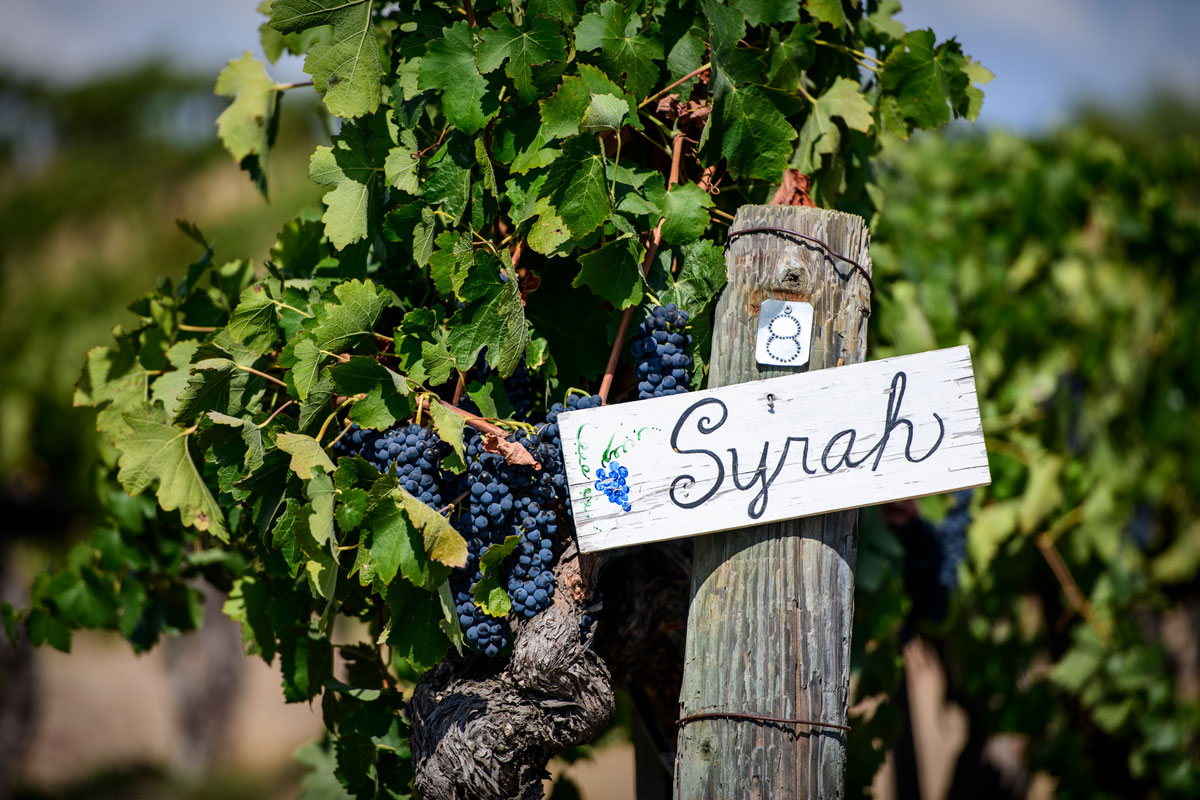
Wine Culture Magazine

Raise a glass to this love grape on February 16, International Syrah Day. Michael Valdez/iStock/Getty-Images Plus photo
Syrah is grape with a distinctive, and delicious, duality.
Is it juicy and jammy? Lean and spicy? Powerful? Elegant? All of the above. It is a wine that stands on its own, but blends well with others — indeed, it is the only red grape the French allow to be blended with a white one (Viognier), outside of Champagne — and gets along companionably with a dozen other varieties in the classic wines of Châteauneuf-du-Pape. It is a classic Old World wine that has found comfortable footing in the New World. It even has two names, Shiraz and Syrah.
That duality is naturally built in. Although the Shiraz moniker has given rise to the belief that the grape originated in Persia, DNA profiling has found that the variety is a cross of a dark-skinned, fruity, somewhat savoury red grape called Dureza from sunny southern France with another one called Mondeuse Blanche, a floral, nutty, plummy white from the high-elevation, cooler climate Savoie region in the French Alps.
In short, Syrah is fascinating, and we should all raise a glass to this lovely red wine on February 16, International Syrah Day.
Syrah found its natural home in the Rhône Valley during the 18th century. Even today, the most famous examples come from the Northern Rhône, from appellations like Hermitage and Côte-Rôtie, where Syrah is the only red grape that is permitted to be grown. These wines tend to be more elegant and restrained, with higher acids, than Syrahs from the south, where they are often blended with Grenache and other juicy, sun-soaked, garrigue-scented grapes.
In the 1830s, the first Syrah cuttings were brought to Australia and by the middle of the century what became known locally as Shiraz was growing happily in the Hunter and Barossa Valleys. No one is sure where the Shiraz name came from, but it now indicates a certain style of Syrah: fuller-bodied, fruitier, with riper tannins and higher alcohol. And today, Australia is the world’s second-largest producer of Syrah/Shiraz, after France.
(Just in case you weren’t already confused, there is also Petite Sirah, a grape discovered in the 1860s, which was actually called Durif, after the botanist who created it, but rebranded Petite Sirah when it was introduced to California. And yes, it tastes a lot like Syrah.)
Syrah is now grown in many regions in many countries the world over, picking up unique terroir characteristics in each. British Columbia’s Okanagan Valley, for instance, produces exceptional Syrah that balances the elegance of the Northern Rhône with the juiciness of the south; the Black Sage Bench is especially well-known for its plummy, peppery Syrah with hints of dusty sagebrush, but fine versions are also grown in the Similkameen and on the Golden Mile and Naramata Bench.
Tragically, though, Syrah is highly vulnerable to cold and the B.C. vines, especially in the South Okanagan, have been decimated during the killing frosts of the last two vintages. B.C. Syrah will become a rare variety, and an expensive one, too, in the coming years.
But wherever your Syrah is from, you can almost always expect to find intense fruit notes — black plum is classic, but you can also detect cherries, blackberries and raspberries — and a peppery spice. Depending on the wine, you might also come across savoury notes of olives, cured meats, leather, tobacco and smoke, as well as floral and herbaceous ones.
Syrah, with its well-integrated tannins and subtle spice, is also very food friendly. Cooler climate Syrah, with its higher acid, elegant red and black fruit, and earthy notes, goes well with game, duck, mushrooms, stews, veal and pastas with meat ragù. Riper, fruit-forward Shiraz is great with burgers and BBQ ribs. Both styles complement grilled, braised or roasted beef, lamb and other meats.
So on February 16, throw some lamb on the barbie, dust vit generously with pepper, and pour yourself a glass of Syrah/Shiraz. And don’t forget to post your toast with the following hashtags: #SyrahDay #ShirazDay #Syrah #Shiraz #Syrahgrape #Shirazgrape #SyrahShiraz #February16.

(Crozes-Hermitage, Rhône Valley, France, $30) Biodynamically grown; red fruit-forward,(cherry, cranberry), with meaty and peppery notes; lovely soft tannins. Power and elegance in balance.

(Châteauneuf-du-Pape, Rhône Valley, France, $108) A blend of all 13 grapes allowed in Châteauneuf; classic, sunny, medium-to full-bodied; cherry, red plum, cocoa, Provençal garrigue, peppery spice.

(South Australia, $49) Ripe, robust, full-bodied but well-balanced, with loads of black berry flavours as well as touches of chocolate, licorice, spice and tobacco.

(Similkameen Valley, B.C., $44) Bold and savoury; black plums, cured meats, leather, olive, sagebrush; the high-elevation Lazy River Vineyard adds acidity and herbal notes.

(Naramata Bench, B.C., $40) Co-fermented with 6% Viognier; pretty floral nose; violet, red plum, black raspberry, leather, cacao; medium body, soft tannins, elegant.

Joanne Sasvari is editor of Vitis and The Alchemist magazines. She also writes about food and drink for WestJet and Vancouver Sun, and is author of the Wickaninnish and Vancouver Eats cookbooks.

Joanne Sasvari is editor of Vitis and The Alchemist magazines. She also writes about food and drink for WestJet and Vancouver Sun, and is author of the Wickaninnish and Vancouver Eats cookbooks.
@ Vitis Magazine